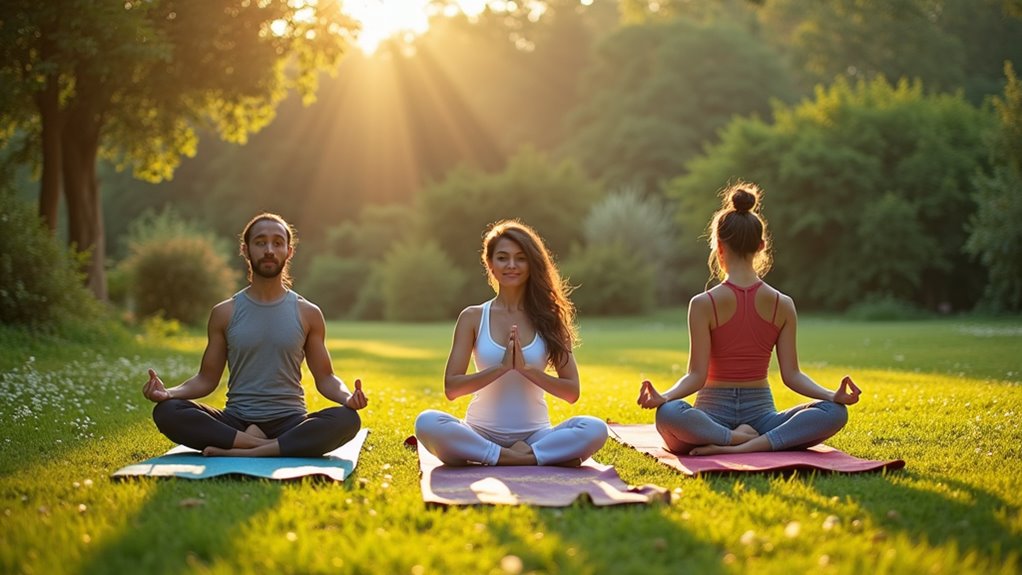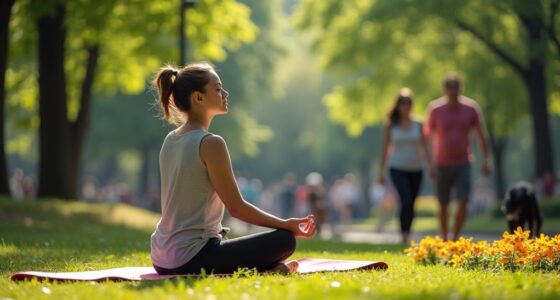Yoga’s a fantastic way to boost your physical and mental well-being. It combines postures, breathing, and meditation to improve flexibility, strength, and stress relief. As a beginner, start with essential poses like Mountain Pose and Downward Facing Dog. Prioritize safety with proper alignment and mindful breathing. Avoid common pitfalls like holding your breath or rushing through your practice. With the right equipment, like a mat and blocks, you’ll thrive in your journey. Explore more to discover all its benefits!
Key Takeaways
- Yoga is a holistic practice that enhances physical health, emotional well-being, and stress reduction through postures, breathing, and meditation.
- Essential poses for beginners include Mountain Pose, Downward Facing Dog, and Warrior Poses, promoting strength, flexibility, and stability.
- Practicing yoga safely involves listening to your body, maintaining alignment, and using props for support.
- Common mistakes to avoid include holding your breath, rushing through poses, and neglecting core engagement for better stability.
- Basic yoga equipment includes a mat, blocks, and straps, which enhance comfort and accessibility for all practitioners.
Understanding Yoga and Its Benefits
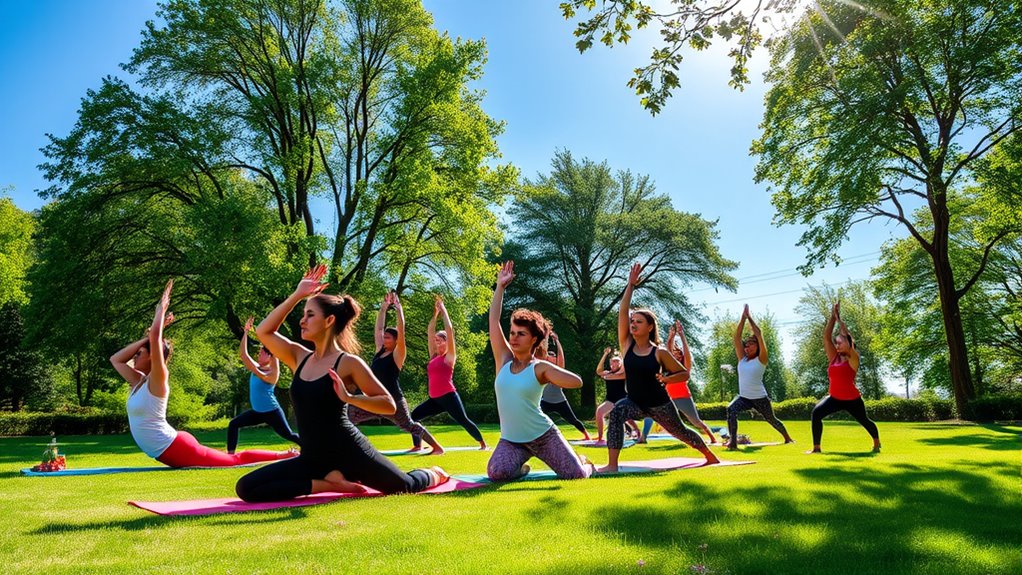
When you immerse yourself in yoga, you’ll discover a holistic practice that blends physical postures, breathing techniques, and meditation to boost both your mental and physical well-being.
The benefits of regular yoga practice are profound. Not only can it improve posture and enhance flexibility, but it also promotes stress reduction and mental well-being through mindfulness. Engaging in yoga helps you cultivate body awareness, leading to better emotional health and resilience against daily challenges. Additionally, practicing yoga can enhance your vibrational state, aligning you with your desired realities as emphasized by Abraham Hicks on sleep and dreams. Incorporating practices like breath control can further enhance your yoga experience. Furthermore, the practice of yoga encourages emotional resilience, aiding in coping with challenges that arise in daily life.
Regular yoga practice significantly enhances posture, flexibility, and mental well-being, while effectively reducing stress through mindfulness.
Studies indicate that yoga can aid in weight management and alleviate chronic pain, enhancing your overall quality of life. Additionally, yoga’s holistic healing promotes benefits that address physical, mental, and emotional health.
Accessible to people of all ages and fitness levels, yoga focuses on personal progress, making it a valuable addition to any healthy lifestyle.
Essential Yoga Poses for Beginners
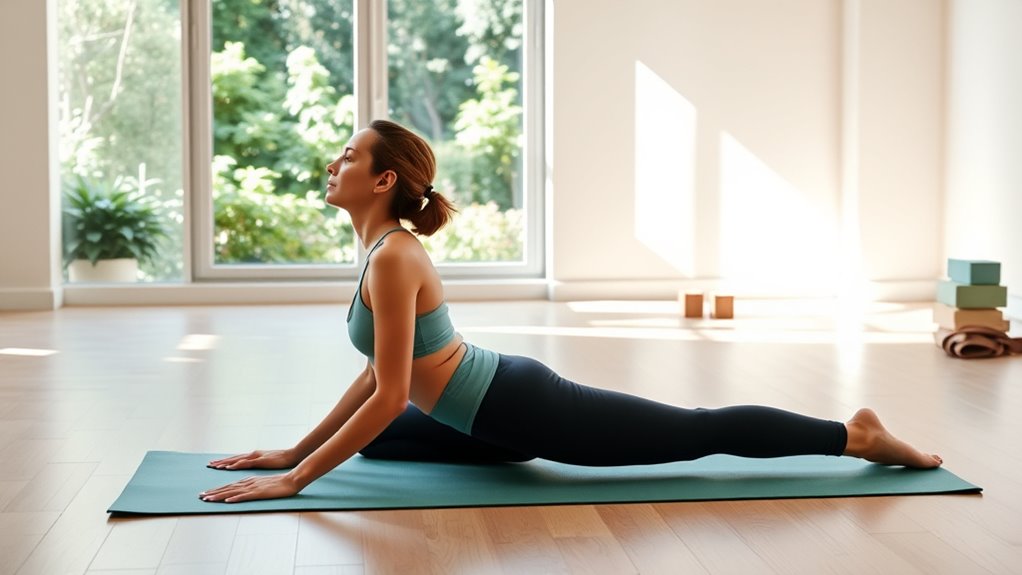
Yoga offers a variety of essential poses that are perfect for beginners, helping you build a solid foundation for your practice. These poses enhance flexibility, core strength, and relaxation, making them vital for your journey. Additionally, incorporating chia seeds into your diet can support hydration and digestive health, complementing your overall wellness routine. A well-rounded diet, including essential fatty acids, is important for maintaining overall health while practicing yoga. Eating a variety of nutritional foods can further enhance your energy and support your yoga practice. Following a raw food diet may also aid in increasing energy levels and improving digestion.
| Pose | Benefits | Focus |
|---|---|---|
| Mountain Pose | Improves posture and alignment | Stability |
| Downward Facing Dog | Stretches the entire body | Flexibility |
| Warrior Poses | Builds strength and stability | Alignment |
| Seated Forward Bend | Enhances flexibility in hamstrings | Gentle stretching |
| Child’s Pose | Promotes relaxation and recovery | Stress relief |
| Tree Pose | Strengthens core and improves focus | Balancing |
Incorporating these essential poses will set you on the path to a fulfilling yoga practice.
Tips for Practicing Yoga Safely
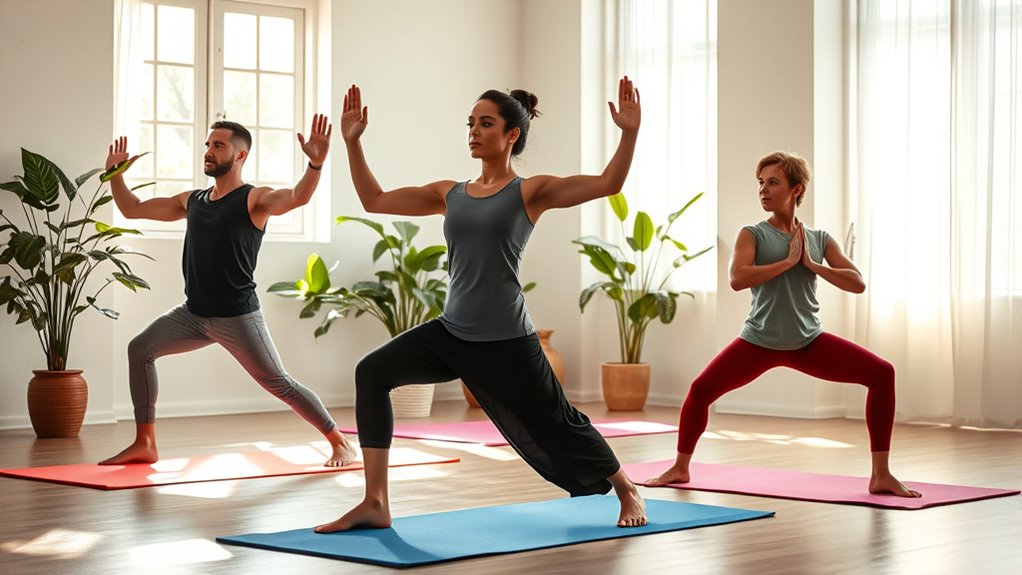
Practicing yoga safely is essential for enjoying the full benefits of your sessions and preventing injuries. Keep these tips in mind to enhance your safety and awareness during practice:
- Always listen to your body; distinguish between discomfort and pain. Modify poses as needed.
- Maintain proper alignment in each pose to prevent injury and improve effectiveness. Incorporating whole foods into your diet can further support your overall health during yoga practice. It’s also beneficial to ensure proper airflow in your environment to enhance focus and relaxation.
- Use props like yoga blocks or straps to enhance accessibility, especially as a beginner.
- Focus on your breathing; mindful breathing fosters stability and calmness in poses.
- Gradually increase the complexity and duration of your practice, allowing your body to adapt comfortably. Additionally, incorporating nutrient-rich juices can support your recovery and overall wellness.
- Consider incorporating freshly squeezed juices into your post-yoga routine to replenish nutrients and aid recovery.
Common Mistakes to Avoid
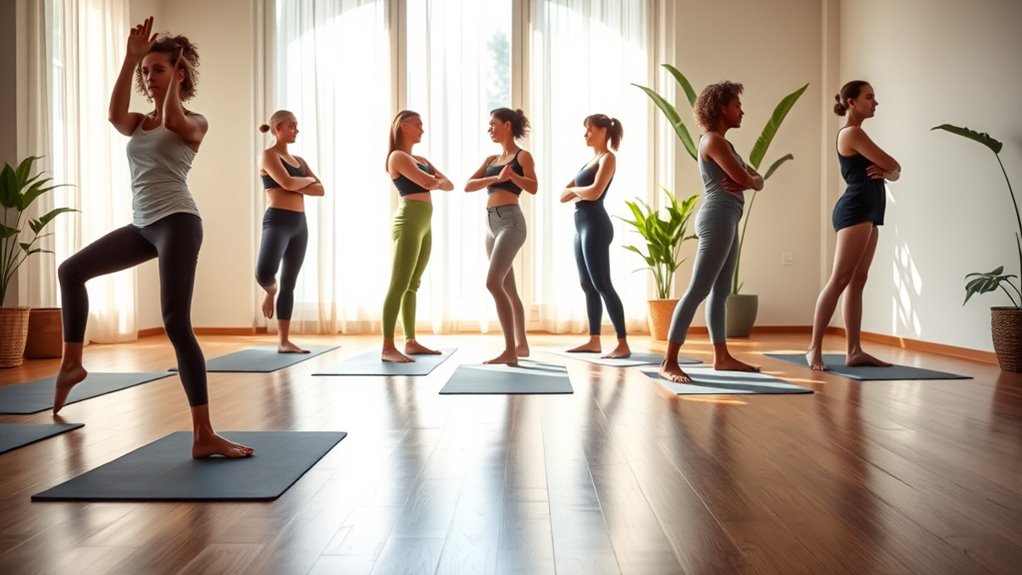
Many beginners unknowingly make common mistakes that can hinder their progress and lead to injury. To improve your practice, focus on proper alignment, especially in standing poses, making certain your knees align over your ankles. Avoid forcing your body into poses; listen to your limits and use modifications when needed. Deep breathing is vital—many beginners hold their breath, which can reduce relaxation. Engaging in mindfulness techniques can also help you stay present during your practice. Additionally, incorporating essential oils may enhance your relaxation and focus. Don’t rush through poses; hold them for several breaths to build strength and flexibility. Engaging your core muscles is essential for stability and balance. Moreover, understanding the importance of proper alignment in yoga can significantly improve your overall practice. Additionally, practicing deep breathing can enhance your overall yoga experience and relaxation.
| Common Mistakes | Solutions |
|---|---|
| Holding your breath | Practice deep breathing |
| Misaligned knees | Make certain of proper alignment |
| Rushing through poses | Hold poses longer |
Yoga Equipment for Beginners
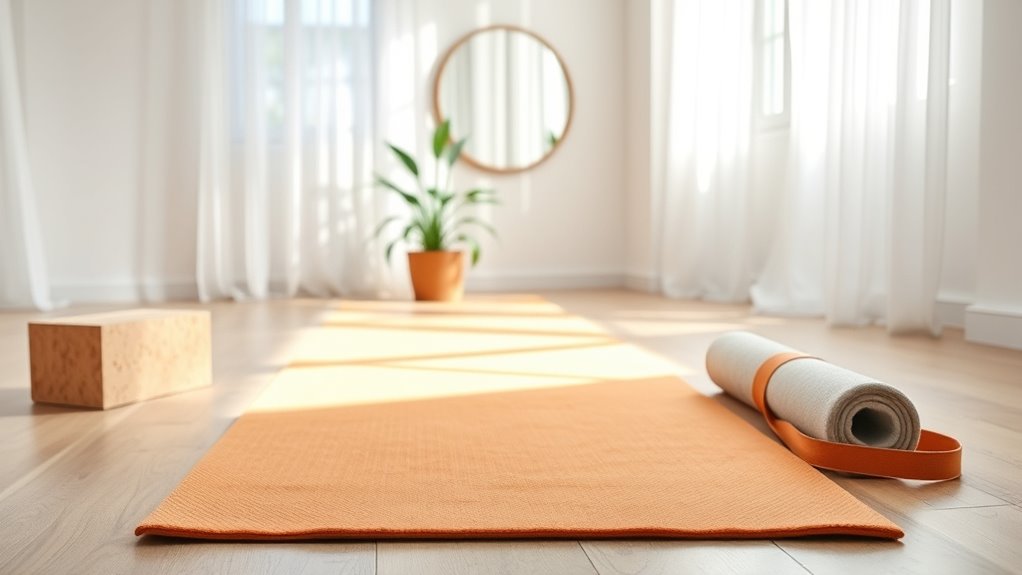
What equipment do you need to enhance your yoga practice? Having the right gear can make a significant difference, especially for beginners. Here’s a list of essentials to help you get started:
- Yoga mat: Provides grip and cushioning for comfort.
- Yoga blocks: Offer stability and support, helping you maintain proper alignment.
- Strap: Extends your reach in poses, improving flexibility without straining. Mindful decluttering strategies can enhance your focus and relaxation during practice. Additionally, utilizing proper oil selection can create a calming atmosphere if you choose to incorporate essential oils for relaxation and stress relief during your practice.
- Bolster: Supports restorative poses, making them more accessible and relaxing.
- Comfortable clothing: Opt for moisture-wicking fabrics to guarantee ease of movement and minimize distractions.
Investing in these items will enhance your practice, allowing you to focus on your form, support, and overall experience. Additionally, dilution guidelines can be helpful if you choose to incorporate essential oils for relaxation and stress relief during your practice.
Enjoy your journey into yoga!
Frequently Asked Questions
Which Pose of Yoga Is Best for Beginners?
When you’re starting yoga, Mountain Pose (Tadasana) is a great choice. It helps you establish proper alignment and improves your posture, setting a solid foundation for other poses.
You can also try Child’s Pose (Balasana) for relaxation and stress relief. Additionally, Downward Facing Dog (Adho Mukha Svanasana) strengthens your body and increases flexibility.
All these poses will build your confidence and enhance your practice as you progress on your yoga journey.
What Happens if I Do 30 Minutes of Yoga Everyday?
They say, “A journey of a thousand miles begins with a single step.”
If you practice 30 minutes of yoga daily, you’ll notice remarkable changes in your body and mind. You’ll feel less stressed and anxious, enjoy improved flexibility and strength, and even manage your weight better.
Plus, your mental clarity will sharpen, and your sleep quality will enhance. With consistent effort, you’ll embrace a healthier, more balanced lifestyle.
How Should a Beginner Start Yoga?
To start yoga as a beginner, find a comfortable space and begin with basic poses like Mountain Pose and Child’s Pose.
Practice at least once a week, gradually increasing your sessions as you grow more comfortable.
Focus on your alignment and breathe mindfully to enhance relaxation.
Don’t hesitate to use props like blocks for support.
Most importantly, listen to your body—distinguish between discomfort and pain, and consider seeking guidance from an instructor.
Can You Lose Belly Fat Doing Yoga?
You can’t expect to lose belly fat solely through yoga, but it can definitely help.
By practicing poses like Boat Pose and Plank Pose, you engage your core, which tones your abdominal muscles.
Plus, yoga reduces stress and enhances mindfulness, leading to better food choices.
When you combine yoga with a balanced diet and other exercises, you’ll promote overall weight management, making it easier to shed that stubborn belly fat over time.
Conclusion
As you roll up your mat and step off the journey of your yoga practice, remember that each pose is a step toward balance—like finding your way home. Embrace the tranquility that blossoms with every breath, and let the lessons of patience and self-discovery guide you. You’ve opened the door to a world of wellness; now, dance through it with grace and confidence. Keep practicing, and watch as yoga transforms not just your body, but your spirit too.
